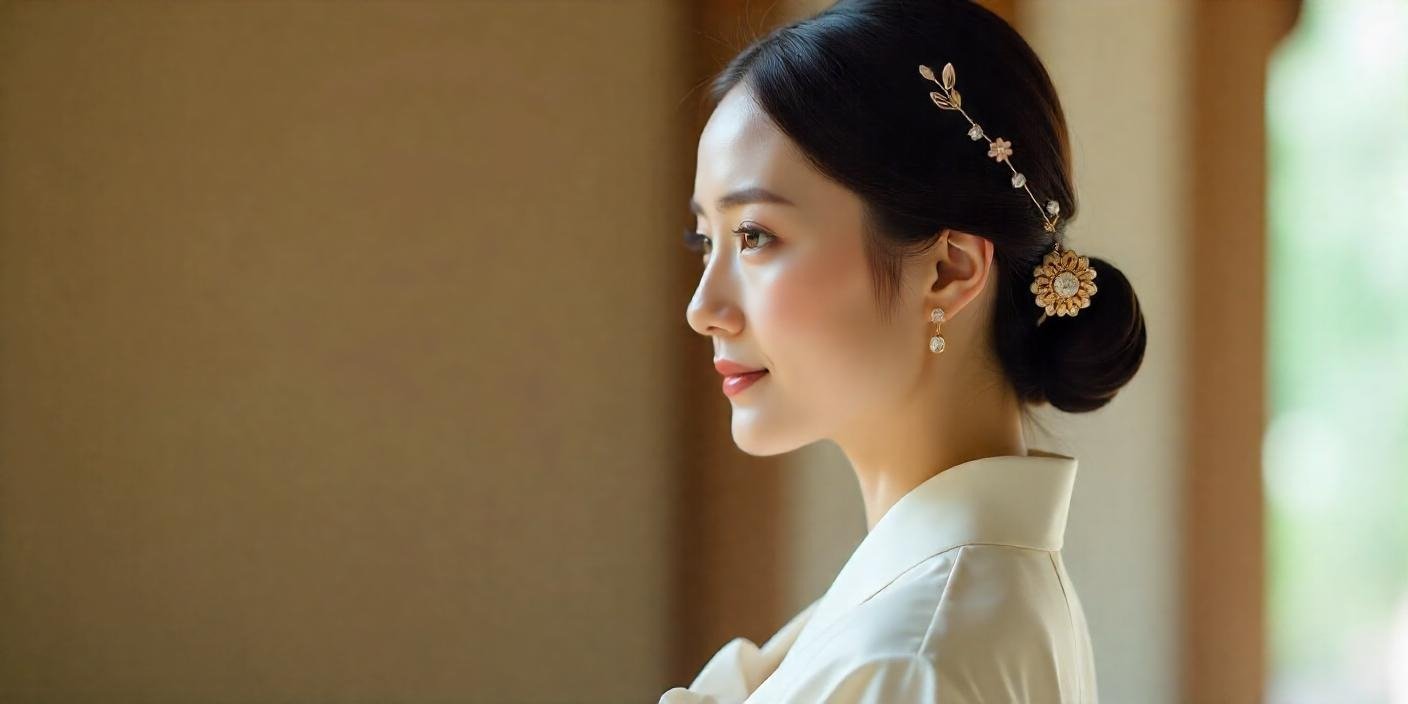Korean wedding hairstyles beautifully blend traditional and modern elements, reflecting both a deep respect for cultural heritage and a desire to embrace contemporary trends. The symbolizing of grace through these styles is a key element that completes the bridal look, where the hairstyles not only complement the hanbok but also add a personal touch to the bridal beauty.
Accessories like binyeo, hairpins, and the exquisite hwagwan crowns enhance the overall elegance, while the delicate daenggi ribbons introduce a traditional flair. Whether it’s the sleek updos or soft waves, the hairstyle showcases a fusion of both traditional customs and modern beauty, creating a stunning visual that reflects the unique beauty of the bride.
Traditional Korean Wedding Hairstyles:
Historical Context:
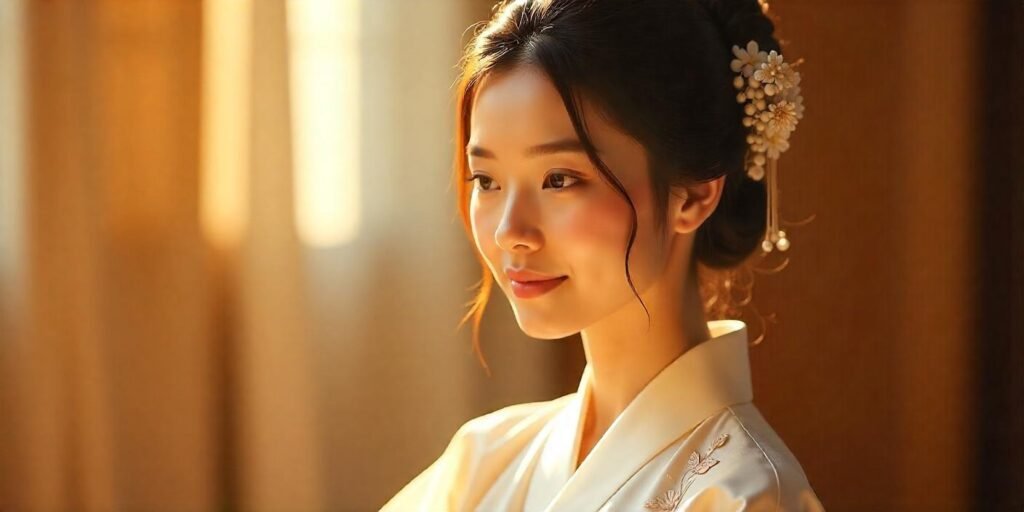
Korean wedding hairstyles are influenced by Confucian values and the Joseon Dynasty, symbolizing modesty, elegance, and respect for tradition.
The bride’s look was designed to reflect purity, humility, and a graceful, understated aesthetic, marking the transition into married life.
These hairstyles were not just a fashion choice but a representation of cultural values and the significance of marriage.
Key Elements:
Binyeo:

A traditional hairpin worn by brides, it symbolizes marital status. Made from jade, gold, or other precious materials, it often features dragon motifs, representing harmony and prosperity. Its style varied, but it remained an important part of the bridal style.
Jokduri:
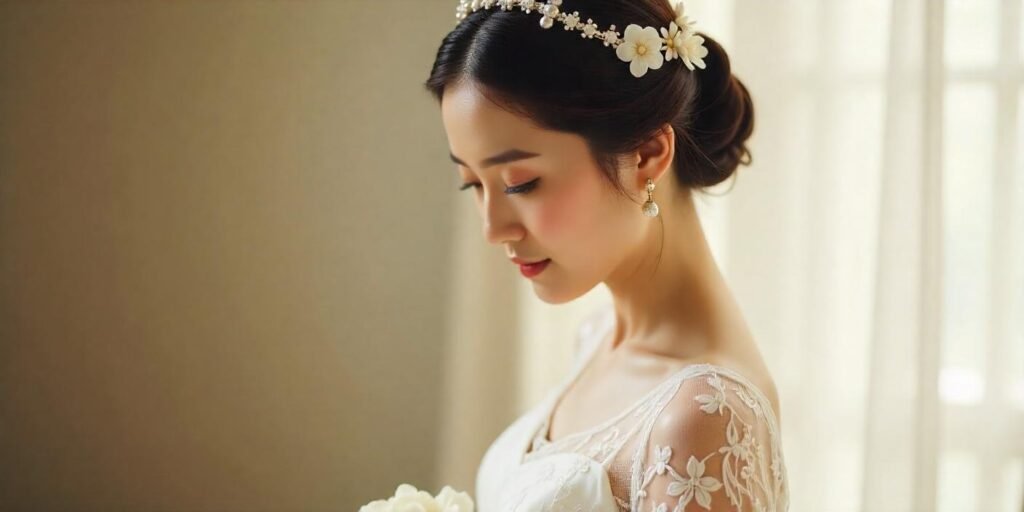
A crown-like headdress is an important part of a Korean wedding hairstyle. Worn with updos, it is decorated with stones, flowers, or other fine accents. It symbolizes the bride’s role as the new head of her family, while also reflecting the groom’s respect and admiration.
Tteoljam:
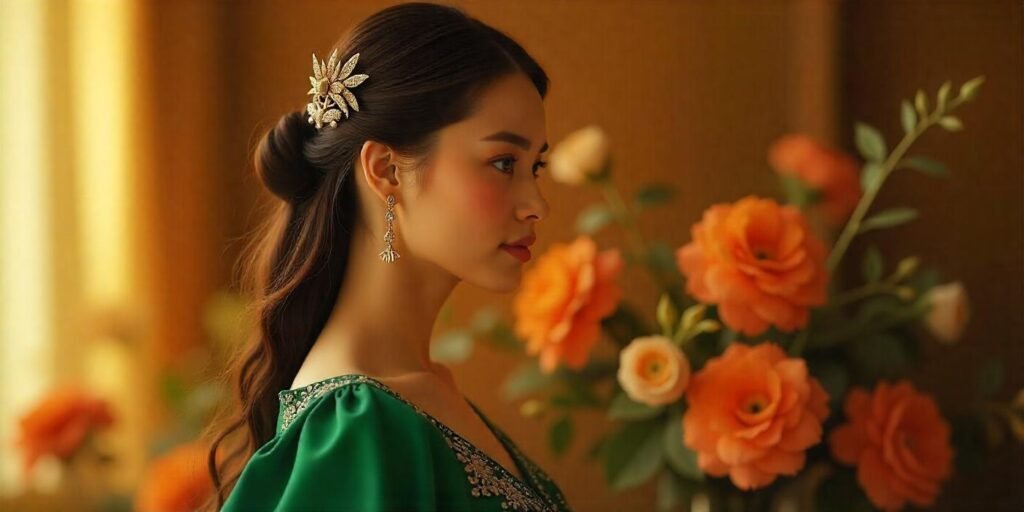
Ornamental pins with mythical motifs are used to add visual complexity and beauty. These pins create a sense of grandeur and elegance, making the style more intricate and symbolically significant, emphasizing grace.
Styling Process:
Creating a traditional look involves intricate work and securing accessories like the binyeo and jokduri. Historically, human hair wigs, known as gache, were used, dyed in natural colors to match the hair and achieve the perfect updo.
Modern Korean Wedding Hairstyles:
1.Western Influences:
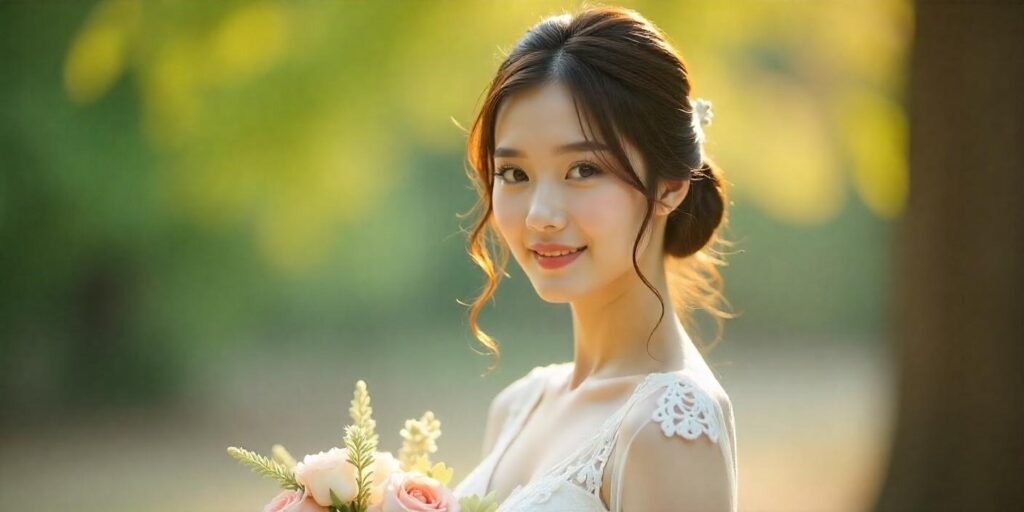
In recent years, wedding trends have influenced Korean bridal hairstyles, with many opting for low buns and half-up hairstyles for a more relaxed, elegant look. These options blend well with traditional attire, offering a stylish balance for photo ceremonies.
2.Celebrity and K-Drama Impact:
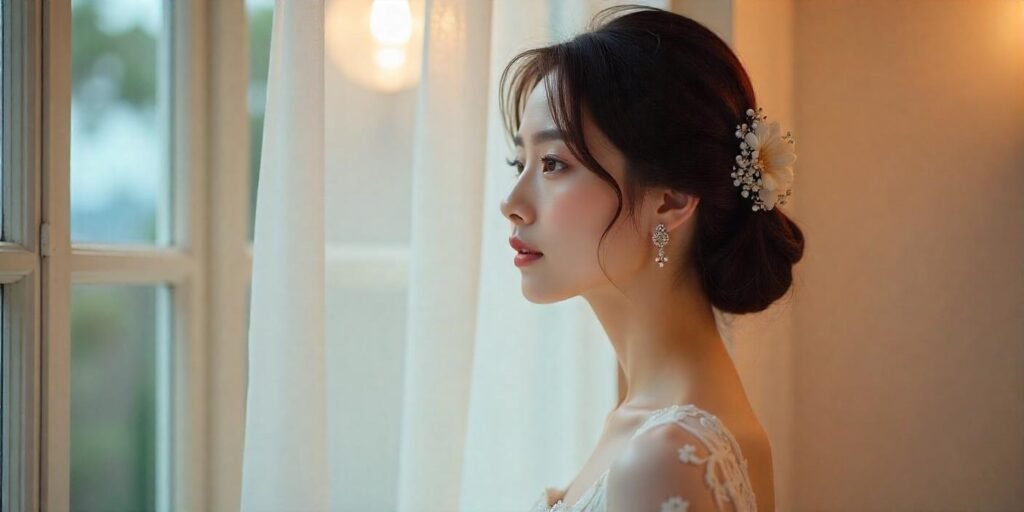
Korean celebrities and K-dramas have greatly influenced bridal hairstyles. Stars like Son Ye-jin, with her soft curls and minimalist binyeo, have set new standards. K-pop and TV dramas inspire brides to mix traditional and modern styles, creating elegant and unique looks.
3.Fusion Trends:
Traditional items are blended with minimalist form accessories, reflecting a connection to the past while embracing the evolving aspects of the new in contemporary ceremonies.
Symbolism and Cultural Significance:
1.Hair as a Symbol:
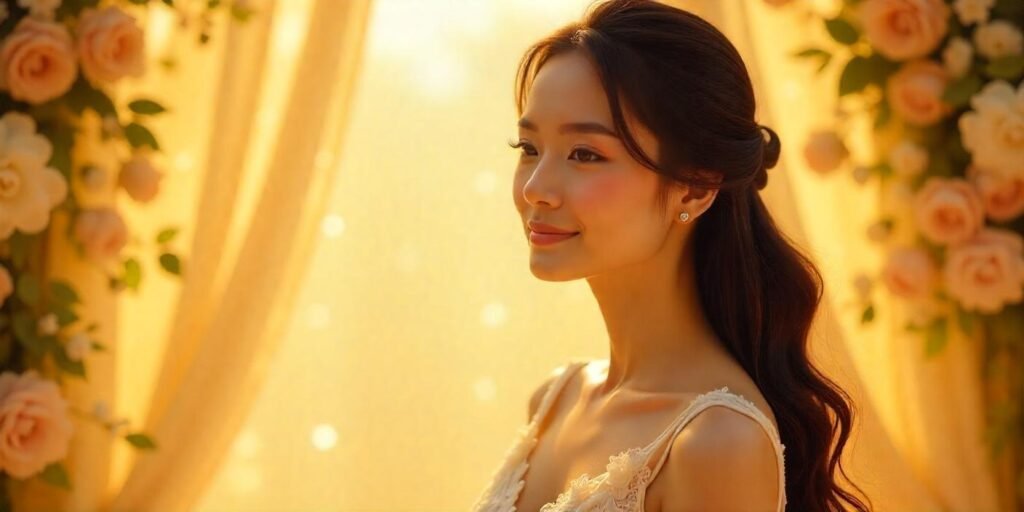
Hair holds deep symbolic importance. The way it’s styled reflects beauty, virtue, and marks a transition into a new role in society and family. It symbolizes a changing status and the physical and symbolic transformation as one enters married life.
2.Color Symbolism:

Blue symbolizes serenity and stability, while red represents vitality. They appear in the attire and accessories, creating a meaningful, aesthetic style that reflects both symbolism and beauty.
3.Rituals:
Hair preparation is an important step, where a respected elder styles the hair. It symbolizes readiness for marriage and commitment to a new life. It’s a meaningful tradition marking the transition into a new chapter.
Popular Hairstyles and Step-by-Step Creation:
1.Traditional Updo:
A> It starts with neatly parted hair, followed by intricate twists to form a base, reflecting the importance of the event.
B> Hair is arranged with intricate designs and secured to stay in place during the event, remaining flawless throughout.
C> The hair features a jokduri, a decorative coronet, and a binyeo pin, symbolizing grace and respect while maintaining its beauty.
2.Modern Styles:
A> The hairstyle often features curls or gentle waves, creating an effect of volume and depth.
B> Choosing a veil or tiara adds sophistication, creating a refined and timeless look.
C> Hairstyles incorporate traditional elements with minimalist designs. A binyeo can be used for a classic touch, allowing the incorporation of both heritage and contemporary aesthetics.
3.Stylist Role:
A stylist is essential in creating the ideal hairstyle, balancing classic touches with contemporary style to ensure it is practical for the long day of events. Their expertise guarantees the hairstyle remains flawless throughout the celebration.
Traditional vs. Modern Accessories:
Traditional:
- Jokduri: Worn by brides, this accessory represents their status and is crafted from silk with fine details, connecting the bride to her roots.
- Hwagwan: To create a beautiful look, it represents a significant part, marking a new chapter in life.
Modern Additions:
Brides today wear crystal tiaras and lace veils, which complement gowns and contemporary styles, adding a timeless feel.
Tips for Non-Korean Brides:
1.Cultural Appreciation vs. Appropriation:
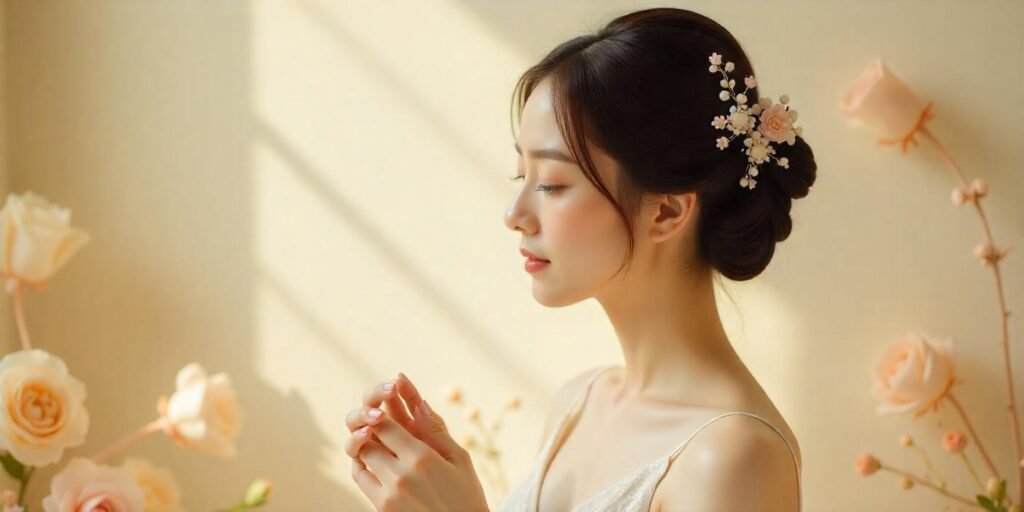
When choosing a hairstyle, it’s important to focus on cultural respect. Incorporating pieces like the binyeo and jokduri shows respect for their cultural significance. Rather than adopting the full look, do so with care to honor the tradition authentically.
2.Practical Advice:
Prioritize a style that stays intact through long ceremonies and multiple stages. Consult a stylist experienced in Korean bridal styles to ensure it suits the day’s demands.
Cultural Etiquette and Considerations:
Respecting Traditions:
When attending a Korean wedding, it’s important to respect the importance of wedding styles. To fully understand the meaning, it’s helpful to seek advice from family members or experts for guidance.
Ceremonial Adaptations:
It’s important to select a style that stays secure during rituals like pyebaek, where the woman bows to the groom’s family. A well-secured appearance allows you to focus on the ritual without worrying about it.
Conclusion:
Korean wedding hairstyles beautifully combine both old and new traditions, offering a rich symbolism that spans generations. These styles reflect the graceful heritage of Korean customs, evolving over time while staying rooted in their cultural significance.
The beauty of these designs is in their ability to remain relevant despite changing trends, making them a timeless choice for modern brides. Whether adorned with traditional hairpins or a more modern twist, these looks showcase an elegant journey through history and offer a sense of continuity that honors both the past and future. Each hairstyle, whether simple or intricate, carries with it the grace of heritage, reminding us of the enduring nature of love and commitment in Korean culture.

